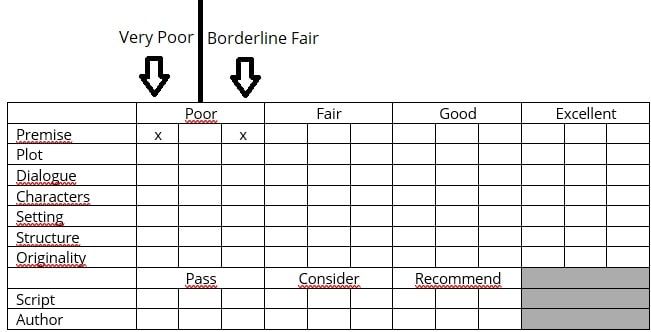Script Coverage: What Is It & Why Do You Need It?
Rent film gear from local filmmakers.

Rent film gear from local filmmakers.
If you're running a production company, you probably know the feeling of getting sent around a hundred scripts a day. That's why you need a script reader to do script coverage!
Script coverage can help you spend less time reading through screenplays and more time making the best screenplays come to life.
If you're planning on script coverage for your company, check out our FREE script coverage template.
If you are doing filmmaking professionally, you probably need a ton of different documents. We have gathered all of our FREE film production templates here.
What is script coverage?
Script coverage is the task you give script readers to analyze and evaluate a script. You make this evaluation a document that allows an analysis getting cut down to just a few pages.
The document includes several general information you need to know. Such as who wrote it and what the script's setting is.
It also includes a general evaluation of the script overall with different categories like the plot, setting, and structure.
Why should you use script coverage?
If you are drowning in screenplays hiring script readers is a great way to sort between the options. A script reader is a person that reads through and evaluates a script based on a set of criteria.
They then fill out a script coverage document they send your way, with their recommendation and a summary of the script. It cuts down your time spent reading screenplays by a lot.
It is common practice for production companies that receive a lot of screenplays. And it is a vital thing to keep your business running optimally.

How does script coverage work?
First of all, you supply your script reader with a standardized document they can fill out.
The document is in two parts:
The first part is general information about the script, as well as a synopsis and additional comments.
The second part is a table where the script reader marks different categories from poor to excellent.
We will now go into full detail about each part of the document.
The four elements of a Script Coverage
1. General Information:
The script reader starts the document by writing general information that is needed. It includes the title, author, submission date, script reader, script coverage date.
It also includes the submitter, the agency of the scriptwriter, and to whom it is submitted. These details are necessary for keeping all of the general information in order.
2. Script Details:
In this section, you dive into details with the script and what it contains.
The script reader classifies the format, typically a screenplay, and how many pages it has. It gives an idea of how long the film would be.
The reader then fills out the genre and the when and where of the script setting. It gives a general idea of the overall setting and feel of the script.
Lastly, they fill out the target group, if any directors or actors are attached, and note down any similar projects you can compare.
3. Summary:
For the summary, the script reader starts by writing a logline, meaning 2-3 sentences that explain the story. It is a way to get a quick overview of whether the story is a great seller or not.
The script reader then writes a synopsis, which should be no more than a page, as a sum-up of the screenplay itself. It gives an overview of the overall story and how the different parts work.
Lastly, they write any additional comments they might have. It could be improvements, ideas, or general critiques they can send back to the author.
4. Evaluation Table:
Lastly, you have the evaluation table, which has seven different categories for the script. The categories are Premise, Plot, Dialogue, Characters, Setting, Structure, and Originality.
The categories get marked with four different overall ratings Poor, Fair, Good, or Excellent. The script reader puts an "x" in the rating they feel best describes the category.
Each rating's box can be split into three, giving a total of 12 ratings for each category. If you want a more in-depth rating, this is the way to go. It means that the script reader can mark it from very poor to poor but borderline fair, as illustrated in the image below.

The script reader also evaluates the script overall and the author. It can be either a Pass, Consider or Recommend. The evaluation is a crucial part of the table, as it is probably the first thing the supervisor reads when they open the document.
The script reader evaluates the author because there can be potential in working with them in the future.
Lastly, the script reader evaluates the budget needed to turn the screenplay into a film. It is also a crucial evaluation criterion, as a larger budget typically means more risks.
Closing thoughts:
I hope this article helped you understand the importance of having a script reader doing script coverage.
If you want to learn more about filmmaking in general, check out our article covering the filmmaking basics.
Script Coverage FAQ
What is script coverage?
Coverage on a script is the act of reading through a script and evaluating it based on a set of criteria. It is typically done by a script reader, who then documents the evaluation in a few pages for their supervisor to read.
How do you write script coverage?
- General Information: It includes the title, author, submission date, script reader, script coverage date.
- Script Details: It includes the format, length, genre, script setting, and target group.
- Summary: It includes a logline, synopsis, and any additional comments from the script reader.
- Evaluation Table: A table evaluating the Premise, Plot, Dialogue, Characters, Setting, Structure, and Originality. Furthermore, the script reader evaluates the author and the overall script, and the size of the budget.
How long should script coverage take?
An experienced script reader aims for 1 minute per page, and around 2 hours to fill out the script coverage.























